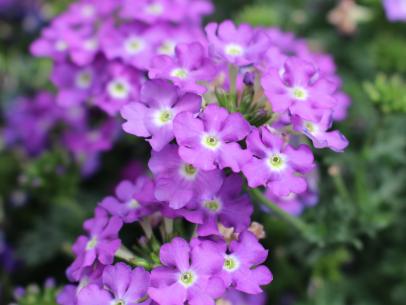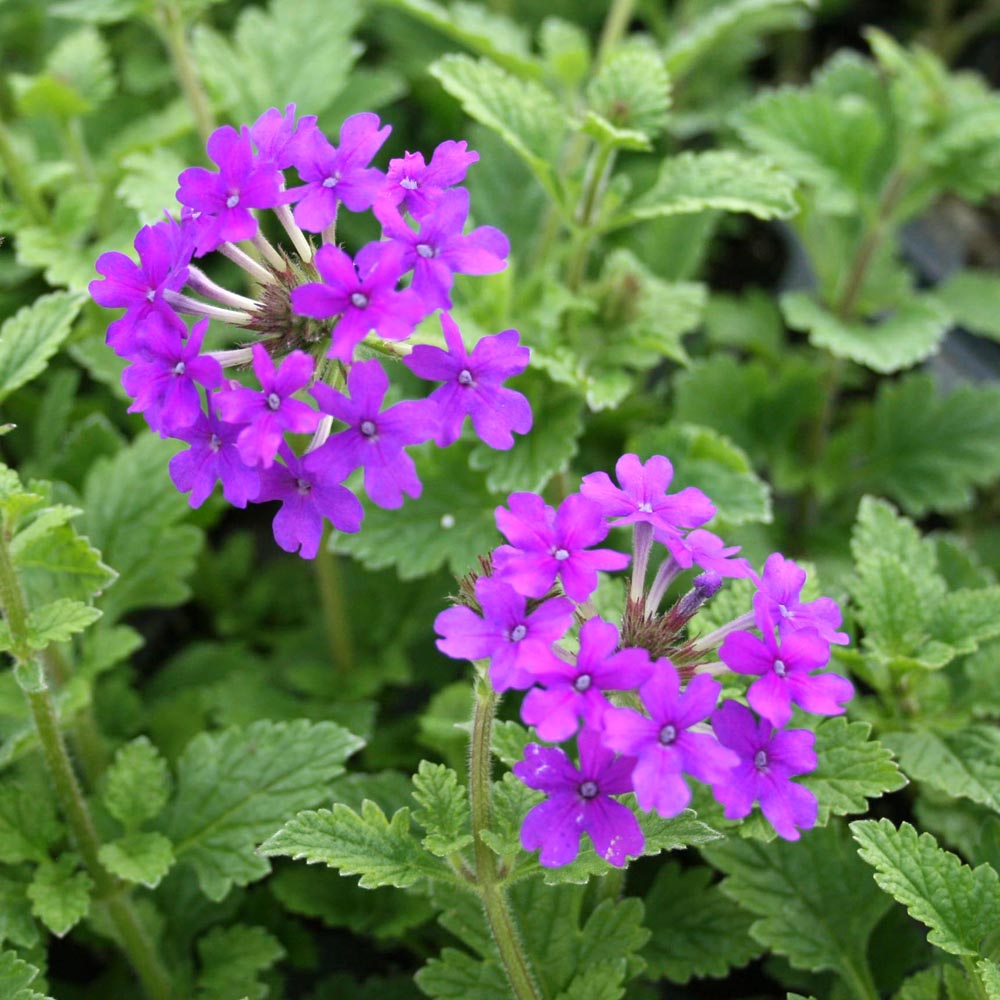:strip_icc():format(webp)/static.onecms.io__wp-content__uploads__sites__37__2020__03__23__verbena-lascar-lavender-star-3f0b530b-4fc251c85a7b4b5e9b5985a7b69dd3a0.jpg)
Verbena is a fantastic cascading plant that can be planted in retaining walls, containers, baskets, and window boxes. This plant produces clusters of blooms all season long, as long as its soil is well-drained. It is also drought tolerant, making it an excellent choice for rock gardens and cracks between stones. Verbena flowers bloom in circles on top of the stem tips, constantly producing new buds. They come in different colors, with fringed edges, stripes, white eyes, and streaks of color. Verbena requires full sun for eight hours and moderately rich, well-draining soil to flourish. It is ideal for climbing fences and trellises, cascading from baskets, or as groundcover. It can be planted in spring when the frost danger has passed, spaced 12 to 18 inches apart. Verbena needs an inch of water once a week until it is established, and it tolerates short periods of drought. Verbena plants are cool-weather stars that flower in spring and autumn but may slow down in the summer heat. An application of a fertilizer with a 3-1-2 ratio, such as 16-4-8, is sufficient unless the plant is growing in poor, sandy soil. Annual verbenas may require trimming up to one-third of the plant if they become leggy. If growing verbena perennials, cut back old stems before new growth starts in spring. Verbena is not a fan of heat and humidity, and annual verbenas struggle in hot, damp summers.

When it comes to issues, verbenas are generally quite disease-free. However, powdery mildew is a potential concern, as it can cause a white residue on the leaves and ultimately lead to a decline in plant health. Although this generally won’t kill the plant, it can slow it down. To avoid powdery mildew, ensure that your verbena is planted in an area with good air circulation and that the leaves have ample time to dry out after being watered or rained on. If you’ve had issues with this disease in your garden in the past, make sure to clear away any dead material from the area and rotate plant placement from year to year.
If you’re interested in growing annual verbenas either in your garden or containers, they can be started from seed. However, if the plant is a hybrid, stem cuttings will result in seedlings that are identical to their parents. To start from seed, simply sprinkle them over moist, well-draining topsoil and keep the soil moist. The seeds will germinate in a few weeks. To propagate using stem cuttings, take a 3-inch stem without flowers and remove all but the top one or two sets of leaves. Plant the cutting in a small pot with moist, well-draining planting medium and cover it with a clear plastic bag. In about six weeks, the stem will begin to root.
It’s worth noting that many common verbenas are hybrids of multiple species.

Introducing the vibrant ‘Aztec Red’ Verbena, also known as Verbena ‘Aztec Red Velvet’. This beautiful plant boasts stunning red flowers with a creamy center and has a spreading growth habit that can reach up to 12 inches. Another fantastic option is the ‘Babylon White’ Verbena, perfect for those who prefer a more classic, elegant look.

Verbena ‘Babylon White’ is a trailing plant that produces pure white flowers. This variety is more resistant to diseases compared to other verbenas. Another variety, ‘Fuego Dark Violet’, has large clusters of rich violet-purple flowers and can tolerate high temperatures well. ‘Fuego Pink’ offers vigorous plants that spread out and bear pink flowers, while ‘Fuego Red’ is a fast-growing variety that produces big clusters of brilliant red flowers.
‘Imagination’ is a popular variety with deep violet-purple flowers that grow up to 12 inches tall and spreads beautifully in hanging baskets. ‘Lanai Lavender Star’ bears clusters of lavender-purple flowers striped in white and grows up to 10 inches tall and 24 inches wide. ‘Lascar Burgundy’ is a mounding plant with medium-sized burgundy-red flowers.
‘Peaches and Cream’ is a showstopper with peach and creamy-white blooms that grow up to 10 inches tall and spread 12 inches. ‘Quartz Purple’ produces rich purple flowers on an upright, compact plant up to 8 inches tall. ‘Quartz Silver’ is a compact, upright variety that has white flowers flushed with silvery lavender and grows 8 inches tall and wide.
‘Temari Patio Red’ offers bright red flowers on mounding plants 14 inches tall, while ‘Summer Snow’ is a trailing selection growing up to 10 inches with pure-white blooms. ‘Superbena Pink Parfait’ shows off soft-pink flowers over fuzzy, disease-resistant foliage and grows up to 12 inches tall and 48 inches across.
‘Superbena Large Lilac Blue’ is a vigorous selection that bears large lilac-blue flowers and can spread up to 4 feet across as a groundcover. It will trail over the sides of a container or hanging basket. ‘Superbena Burgundy’ is a vigorous selection that bears rich burgundy flowers from spring to fall and can spread up to 4 feet across.
‘Tropical Breeze Red and White’ offers good resistance to powdery mildew and shows off white flowers liberally streaked in red, while ‘Tukana Scarlet Star’ features large bright red flowers with a sparkling white eye. It’s heat-tolerant and flowers all summer, growing 8 inches tall and 24 inches wide. ‘Temari Bright Pink’ is a trailing selection with soft pink flowers that bear tiny white eyes and trail up to 1 foot.
Verbena bonariensis is a tall, purple-blooming prairie-type verbena that happily reseeds in the garden. Verbena can attract several pollinators such as monarch butterflies, moths, bumblebees, and hummingbirds with their sweet scent and nectar. They are relatively short-lived, with perennial verbenas coming back for two or three years while annual verbenas are prolific self-seeders. Larkspur, petunias, and snapdragons are excellent companion plants for verbena and add color and charm to any garden.
